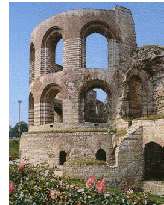Maximian, while still finding refuge within Constantine's household, seizes the treasury at Arles and proclaims himself Augustus once more. Constantine quickly suppresses Maximian's last attempt at gaining power, and ultimately Maximian surrenders at Massilia (Marseilles) where he is forced to commit suicide.
| |

Basilika Palastaula
Augusta Treverorum, the audience or throne hall of Constantine, once part of a greater imperial palace, c. 310.
An even more striking example of the free flow of ideas and techniques is that afforded by the Audience Hall at Trier. At first glance one would take this for an up-to-date but otherwise ultra-typical example of contemporary metropolitan brick-faced concrete masonry. In reality it is built of solid brick, like the Kizil Avlu at Pergamon, and it is thus a seemingly unique example in the West of a method of construction which at this date we find only in Asia Minor. Whatever the eight of conservative architectural tradition in the average provincial city, here in the capitals of the Tetrarchy things were fast moving toward an architecture that was ecumenical in its range, transcending the barriers between one region and another and the even more formidable barrier that still separates East and West. (emphasis added)
J.B. Ward-Perkins, Roman Architecture (New York: Harry N. Abrams, 1977), p. 317.

On the Constantinsplatz stands the brick basilica, probably built during the reign of Constantine the Great. Converted into a palace for the Frankish kings and their deputies, it passed in 1197 to the archibishops. It was later restored (1846-56) and turned into a Protestant church. Adjoining the basilica are the electoral palace (1757-61) and the palace garden.
Wilhelm C. Bracht, "Trier" in Encyclopedia Britannica (Chicago: Encyclopedia Britannica, Inc., 1969) v.22, p. 230.
| |
 
Baths of Constantine
Augusta Treverorum, the largest Roman bath complex north of the Alps, c. 310.

Same Scale Comparison, Baths of Diocletian, Rome, c. 302, Imperial Baths, Trier, c. 310
 
Visual Comparison, Imperial Baths, Trier, c. 310, Torre Pignattara, Rome, c. 320-26
|





